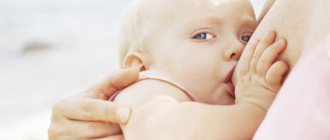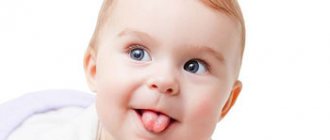Baby at 2 months or too much smiling
Hello, dear readers and young mothers!
For some of you, a significant event has already happened, and for others, a significant event is just ahead - the child is two months old. He has gained height and weight and is now focused not on himself, but on the world around him. The baby knows what his mother's breast is, and every day he is more and more sociable and developed. You understand him better and better.
Are you wondering what your baby can do at 2 months? Then let's read!
Development of a two month old baby
The baby's neck is slowly getting stronger, he can already lift it while lying on his tummy. Particularly lively children can even stand up by this time, leaning on their elbows.
Place your child on his stomach more often so that he has the need to raise his head and thereby train his neck muscles. For the same purpose, hold your child upright during walks and only lightly hold his head: let him look around and turn around to explore the world around him.
Be very careful when removing your baby from the crib. His movements are still sharp and he can jerk his head strongly, so hold it firmly.
Mom and dad so often give their baby their smile! At two months he begins to respond in kind. The child responds to a familiar voice or a parent who appears in the field of view with a radiant smile. When he is in a particularly good mood or something makes him happy, get ready to laugh.
Show your emotions clearly: grimace, exaggerate. Try to make your mood and feelings easy to discern for your little one.
Now, when something falls somewhere, music sounds or a conversation is heard, the two-month-old baby already knows where the sound comes from. He involuntarily turns his head in the right direction.
For better development of the hearing aid, get some kind of “quiet” bell with a pleasant sound. Call them first from the right, then from the left, let the baby listen. However, you should not overdo it with such exercises. 5 minutes of such exercises in 2-3 days is enough.
At 2 months, your miracle already craves communication and does everything possible to start a dialogue with you. It’s no longer a scream, but it’s not yet babbling either – it’s a roar. In the first month of his life, the child could not yet pronounce various “uuuuu” and “aguuu”, but now the room is literally filled with this singing.
Talk to the little one, copy, improve his humming, focus on some sound - he will try to repeat it.
Tiny hands can now open and close. However, the grasping reflex has not yet weakened, so it is much easier for the child to grab something, but there are still problems with unclenching the palm.
When your baby squeezes something, gently unclench your fist and lightly rub your palm and fingers. Experiment with objects that you put in your baby's hand, but make sure that the thing is not too small or too big. Balls are best suited: wooden, plastic, fabric. Each new material will be perceived with interest and caution.
At two months he can already focus on certain objects and even follow them with his eyes. Contrasting colors and dark objects are perceived best. Also, the little one can reach with his hands the toys hanging above the crib.
Many sources write that you need to “drive” a toy at a certain distance so that the child follows it. I believe that this distance should be determined depending on the capabilities of your baby. First closer, then a little further, from a slightly different angle, etc.
The fact that everything is individual applies not only to visual activities. All children are different. Some people have difficulty holding their head at 3 months, while others do it confidently at 2 months. There is no need to worry or be nervous - everything has its time. This is especially true for premature babies. I have more than once encountered the fact that parents completely forget about this point and begin to “run across the ceiling” when they discover some kind of deviation from the norm. Take care of yourself and your little one, everything will be fine.
Caring for a two month old baby
Bathe your baby every day. If you want to add herbs or some special cosmetics to the bath, you should do this no more than twice a week.
Marigolds grow very quickly at this age and are extremely sharp. The baby can and will get hurt by them if measures are not taken. Therefore, carefully monitor this and do your manicure on time.
Massage is necessary. Gentle, correct, regular. Thanks to massage, you can relieve colic, develop joints and bones, and help blood circulation.
After making sure that there is no draft and the room is warm and comfortable, leave the baby naked. Let him not be embarrassed by diapers or diapers. Initially, the duration of this procedure should not exceed 2-3 minutes, and over time it can be increased to 10 minutes.
Observe the condition of the ears and nose and clean if necessary. This can be done with special devices or a cotton swab. The tampon can be pre-moistened with special baby oil.
If this is a woman’s first child, then she is incredibly attentive to him and perceives any deviation from the norm as something abnormal or strange. The young mother monitors how much the baby eats, counts the number of smiles per day and immediately runs to the doctor for advice. Fortunately, most often she hears in response something like “Leave you alone with the child, everything is fine with him.”
Let's look at the most common possible "problems" and your reaction to them.
Possible “problems” and reactions to them
You may smile, but there are a lot of discussions on this topic on the Internet. Calm down, the little one won’t eat his own hand and won’t live like this for the rest of his life. This will pass with age!
Parents are always concerned about how much their little one sleeps. When a baby is 1 month old, he sleeps much more than when he was 2 months old. Only in the rarest cases does a mother get lucky and her baby sleeps the whole night and almost the whole day. In most cases, a baby can “give heat” to its parents for up to a year. This is more the norm than the other way around.
The reasons why your child does not sleep may be: too stuffy, hot or cold, hunger, colic, or being active before bed. You can try playing a certain melody before you lull your little one to sleep, or humming the same song before bed. Then you can develop the reaction you need (sleep) to already familiar sounds.
There are many reasons and, again, everything is individual. Pay attention to how the child looks and how he behaves. If he is active and cheerful, then you have no need to force him or yourself. Well, yes, he doesn’t eat much, he won’t get a certain amount of grams this month, he’ll definitely catch up with what he lost a little later.
You need to sound the alarm when you notice negative changes in your baby’s behavior.
Up to three months, all children regurgitate; only after this period does regurgitation decrease or stop altogether. If the child’s regurgitation is abnormal, then you can consult a doctor. But in this case, there is no need to sound the alarm. There are a lot of examples of how regurgitation beyond the norm did not threaten the child with anything, doctors did not find anything and everything went away on its own.
In order to reduce regurgitation, you need to make sure that the baby does not overeat and after feeding he is not squeezed, but allowed to lie quietly for a while. You can also give your baby special mixtures, but this is only after the doctor’s permission.
"Why is he crying?!" - is this a familiar question? There can be many reasons for concern, the most common being colic. They torment 90% of babies. They are treated with medications and massages that help remove gases.
It may also be that the baby is too accustomed to being carried in arms and constantly requires attention and these very “hands”.
If the mother does not smile and is nervous, then the child will be in the same mood. Try to be relaxed and calm, then this state will be passed on to the little one.
In special cases, you need to contact a neurologist.
When breastfed, the baby has loose stools, but when bottle-fed, they are harder. In any case, you yourself must understand what kind of stool your child usually has. If the baby gains weight and no significant changes are noticeable in the stool, then everything is fine. If the smell, consistency and color change dramatically, then you need to consult a doctor.
Here, in fact, are these babies and their problems at 2 months. What can your child do? How does it surprise and delight you? Please share with us, we are very interested!
Bye!
my-happybaby.ru
What does a newborn's smile mean?
Immediately after birth and until the age of six weeks, the newborn smiles with a so-called artificial or reflex smile. During this period of its development, the baby does not distinguish between surrounding objects, does not always recognize the sounds of voices, and the manifestation of a smile is rather a reaction to the internal processes of the body. The main ones are gas colic in the intestines and the processes of digestion of food in the stomach.
When a baby begins to smile between six and eight weeks of age, it indicates normal mental development. This kind of smile is called a conscious smile. Pediatricians explain that at this stage of development, the newborn recognizes objects around him, distinguishes the voices of relatives, and can focus his attention on external stimuli. In pediatrics, a phenomenon of this type is usually called “manifestation of the revival reflex.”
At two to three months from birth, children begin to comprehend the “social smile.” Such a smile is directed to a specific person, often to parents, as a manifestation of positive emotions. Usually a baby's smile is accompanied by twitching of limbs and sounds. Everything taken together indicates a stable growth process for the baby.
The so-called permanent smile appears when the baby is five to six months old. This period is considered the time of the most active manifestation of feelings in the baby; knowledge of the world occurs through touch, and the reaction is a smile. Smiling at complete strangers during this period is a common occurrence and should not worry parents.
Another sign of normal mental development in children is a “selective” smile. From the age of eight to nine weeks, the newborn gets used to the people who constantly surround him and begins to be distrustful of strangers. Smiling at parents at eight months is the key to normal emotional development of the baby. Doctors classify the period as the most important in terms of children's development.
With the advent of speech, a new reflex arises, which is called laughter. Laughter per year is a reaction to the world around us, it is completely intelligent and conscious.
What to do if your child smiles little?
If a newborn expresses emotions poorly, this is not a cause for concern. Just like adults, children have their own temperament. Until one and a half months, unsmiling is considered normal and has no side effects. When the baby does not know how to smile after reaching two or three months, it is necessary to consult a pediatrician.
The main reasons for the lack of a smile in children:
- Physiological deviations of the cervical spine, there is no ability to hold the head.
- Mental deviations, expressed by a reluctance to communicate with surrounding acquaintances and strangers.
- Impaired coordination of movements, inability to focus attention on external stimuli.
It is impossible to cope with these problems on your own. In such cases, doctors advise undergoing a comprehensive examination of the body to identify the cause of the disorder in the psyche or physiology of the newborn. It is necessary to react to the problem in time and take action. Timely treatment will help get rid of problems in the future development of the baby.
Developmental activities
For the normal development of children, parents must conduct developmental exercises and activities so that the newborn perceives the surrounding space adequately, without fear. When parents smile at their child, this is the best way to provoke a reaction in the baby.
The main thing is to choose the right moment for action. It occurs when:
- The baby lies restlessly in the crib, arms and legs are mobile.
- The child woke up more than an hour ago and lies with his eyes wide open.
- The baby looks for its parents with its eyes.
The mother should start talking to the baby, while not forgetting to smile. Most often, the baby begins to smile back. Children learn from their parents, repeat facial expressions, words, movements, so classes are an important and necessary process in their upbringing.
A smile is an emotional-motor reaction of children to external manifestations. When a baby laughs, this indicates his normal mental, physiological and emotional development.
kidpuz.ru
If the child does not smile
If your child is 3-4 months old and still does not smile, you definitely need to find out the cause of the problem. Perhaps it lies in a dysfunctional family atmosphere - a newborn may be in a state of constant stress and frightened by what is happening around him.
This situation can lead to sad consequences (for example, stuttering or enuresis), so you need to seek help from a pediatric neurologist.
Another reason is lack of communication. In order for a child to learn to smile, you need to talk to him more, carry him in your arms around the room, showing him various objects and toys and arousing his interest in the world around him.
If the baby does not sleep during a walk, you can also take him in your arms and introduce him to plants, trees, animals and everything that surrounds the child at the moment. This has a positive effect not only on emotional and mental development, but also on the development of the senses (vision and hearing).
Question from moms and dads: “When will the baby start smiling?”
The smile of a small child is always a small holiday for his mother, father, and grandparents. And what can we say about the first smile - it’s like a gift from heaven, a reward for sleepless nights and hard parental work. When will the baby start smiling? Why doesn’t he do this, while the neighbor’s kid the same age gives everyone a smile? Many young parents ask these questions. We will try to answer them in our article.
A child’s smile is not only a pleasant event in the life of a family, but also an indicator of normal mental, physical and mental development, the beginning of the baby’s socialization. Therefore, the moment when a child begins to smile consciously is a kind of next step in the long road of his development.
“My child started smiling in the maternity hospital!” - many mothers say. Don't take their words to heart. What they call a smile is just a grimace, an unconscious contraction of certain muscles that looks like a smile.
When answering a question from concerned parents about the appearance of the baby’s first conscious smile, the pediatrician will tell them the age of 1.5-2 months. This smile is usually addressed to the mother (or the person replacing her). Here, a lot depends on the baby’s environment: if from the very first days there are caring parents next to the baby, who communicate with him all the time, often pick him up, maintain eye and voice contact, he will begin to smile at 6 weeks. If the child is given less attention, this will happen only by two months or a little later. Therefore, do not be upset if your child does not smile in a month, there is nothing wrong with that. You just need to wait.
When a child begins to smile, we can talk about the formation of a so-called revitalization complex. This is an emotional-motor reaction of a baby in response to the appearance or address of an adult. This complex begins its formation already at the age of three weeks from birth: the child freezes and looks intently when an adult speaks to him. Later, by two months, this reaction develops into smiling, humming and physical activity when communicating with an adult. The peak of formation of the revitalization complex is four months of age. Later, laughter appears, but the smile is less and less common to strangers, even if they speak kindly to the baby, often he will even cry in such cases.
By how many months a child smiles, one can to some extent judge the atmosphere in the family, the mother’s attitude towards him, and her emotional state. Even if you think that the child does not understand anything, talk to him, this way you will speed up his speech and psycho-emotional development: he will begin to walk and smile earlier.
Experts say that boys make eye contact less often and begin to smile later than their girls the same age. Therefore, if you have a growing son, spend more time communicating with him.
The period when a child begins to smile can be decisive in the development of his relationship with his father. The baby begins to send signals, and if the father responds with facial expressions and voice, a special emotional connection will be established between them, even if there was none before.
The day your child starts smiling will be the beginning of a long but interesting process in his life - socialization.
fb.ru
When to Expect a Smile from a Newborn
By the time the newborn reaches one month of age, he may involuntarily grin in response to such stimuli:
- pleasant and entertaining events: clapping hands, cooing and other manifestations of affection and attention from parents;
- pronounced gestures of the adults who surround him.
Essentially, newborns gradually learn to respond to how they are treated, gain experience in maintaining visual contact with their surroundings, and try to respond to what is happening in the ways they understand.
Signs of normal child development from 1 to 12 months
From user log Elena
26 February 2010, 13:13
AT AN APPOINTMENT WITH A NEUROLOGIST Signs of normal development of a child from 1 to 12 months Quite often, young parents do not quite understand why a newborn examination by a neurologist is necessary. Meanwhile, it allows you to promptly notice the slightest deviations in the baby’s development. Only a doctor can assess the degree of maturity of the baby’s nervous system, the potential capabilities of his body, the characteristics of reactions to environmental conditions, and prevent developmental disorders or their consequences. The foundations of a person’s health or illness are laid at a very early age, so timely diagnosis and correction of existing disorders is one of the main tasks that a neurologist solves during the first examination of a newborn. By the middle of the 1st month, and sometimes earlier, children begin to “meaningfully” look around, fixing their gaze longer and longer on objects that interest them. The first “objects” of increased attention are the faces of the closest people - mom, dad and those caring for the child. By the end of the 1st month, the child begins to quite consciously smile at the sight of loved ones, turn his head towards the source of sound, and briefly follow a moving object. A newborn spends most of the day sleeping. However, those who believe that a sleeping child does not perceive the sounds of the surrounding world are mistaken. The baby reacts to sharp, loud sounds by turning his head towards the source of the sound and closing his eyes. And if they were closed, then the child closes his eyelids even more tightly, wrinkles his forehead, an expression of fear or displeasure appears on his face, his breathing quickens, and the baby begins to cry. In families where parents constantly talk in a raised voice, children's sleep is disturbed, irritability appears, and their appetite worsens. A lullaby sung by the mother, on the contrary, will help the child fall asleep peacefully, and the affectionate, friendly tone adopted in the family creates a sense of security and confidence in the baby in future adult life. At the 2nd month, the child's tone in the flexor muscles of the limbs significantly decreases and the tone in the extensor muscles increases. The baby's movements become more varied - he raises his arms, spreads them to the sides, stretches, holds a toy placed in his hand and pulls it into his mouth. The baby begins to become interested in bright, beautiful toys, looks at them for a long time, touches and pushes them with his hands, but is still unable to grasp them with his palm. Lying on his stomach, and then in an upright position, the child raises his head - this is the first conscious movement that he has mastered. Soon, being in his mother’s arms, he confidently looks around, and at first his attention is attracted by stationary objects located at a great distance. This is due to the structural features of the visual apparatus. Then the baby begins to look at closer objects, turn his head and follow the moving toy with his eyes. During this period, positive emotions predominate in children - smiling, motor animation, humming at the sight of their mother’s face, in response to affectionate treatment. At the 3rd month, the child becomes even more active, begins to roll over first from his back to his side, and then onto his stomach, holding his head confidently. The baby really likes to lie on his stomach, while he leans on his forearms, raises his head and upper body, carefully examines the objects and toys around him, and tries to reach them. Hand movements are varied. Lying on his back, the child quickly and accurately grabs an object placed in his palm and pulls it into his mouth. He already has his own preferences - some toys please him more than others, as a rule, these are small rattles that he can independently hold in his hand. He distinguishes faces and voices of his own and others, understands intonation. At 4 months, the baby improves in the ability to turn from back to stomach and from stomach to back, and sits down with support from the hand. The infant's grasping reflex completely disappears, and is replaced by voluntary grasping of objects. At first, when trying to pick up and hold a toy, the baby misses, grabs it with both hands, makes many unnecessary movements and even opens his mouth, but soon the movements become more and more precise and clear. In addition to toys, a four-month-old baby begins to feel with his hands the blanket, diapers, his body and especially his hands, which he then carefully examines, holding in his field of vision for a long time. The significance of this action - looking at the hands - is that the child is forced to hold them in one position for a long time, which is impossible without prolonged contraction of individual muscle groups and requires a certain degree of maturity of the nervous system, visual analyzer and muscular system. The baby begins to compare his tactile sensations and visually perceived images, thereby expanding his ideas about the world around him. By 5-6 months, the baby confidently takes and holds various objects within his reach. Everything that falls into the hands of a child at this age, after feeling and examining, inexorably ends up in the mouth. This worries and even upsets some parents, as it seems to them that the baby is developing bad habits that will then be difficult to wean. But the fact is that an infant exploring the world, in addition to the sight, hearing and smell familiar to an adult, actively uses touch and taste, the importance of which for the process of cognition at this age is difficult to overestimate. Therefore, in no case should one interfere with the child’s research interest, which strives to “test the teeth” of everything. However, parents should ensure that there are no small or sharp objects nearby that are dangerous to the baby. When communicating with adults, a 4-5 month old child develops a revitalization complex, which includes emotional, motor and speech reactions - smiling, energetic movements, prolonged humming with many vowel sounds. The child turns over on his side and, leaning on his hand, sits down. Lying on his back, he quickly and accurately reaches out for the toy and confidently grabs it. Speech is actively developing, the baby pronounces consonants, the syllables “ba”, “ma”, “da”, babbles, and begins to react differently to mom, dad, relatives and strangers. At 7-8 months, as balance reactions develop, the baby begins to sit up independently, without support, from a position on his back and on his stomach with the help of his hands. Lying on his stomach, he rests on his forearms, his head is raised, his gaze is directed forward - this is the most optimal position for crawling, which is still carried out only with the help of his arms, on which the child is pulled forward, his legs do not participate in the movement. With support, the baby gets to his feet and stands for a short time, and at first he can lean on his toes, and then on his full foot. Sitting, he plays for a long time with rattles and cubes, examines them, transferring them from one hand to another, changing places. A child of this age gradually tries to attract the attention of adults, clearly distinguishes all family members, reaches out to them, imitates their gestures, and begins to understand the meaning of the words addressed to him. In babbling, the intonations of pleasure and displeasure are clearly distinguished. The first reaction to strangers is often negative. By 9-10 months of age, crawling on the stomach is replaced by crawling on all fours, when the crossed arm and leg move simultaneously - this requires good coordination of movements. The baby moves around the apartment at such a speed that it is difficult to follow him; he grabs and pulls into his mouth everything that catches his eye, including the wires of electrical appliances and equipment buttons. Given the capabilities of this age, parents need to ensure the safety of the ubiquitous baby in advance. By 10 months, the child gets up from a position on all fours, pushing strongly from the floor with his hands, stands and steps with his feet, holding onto the support with both hands. The child happily imitates the movements of adults, waves his hand, takes out scattered toys from a box or collects scattered toys, takes small objects with two fingers, knows the name of his favorite toys, finds them at the request of his parents, plays “okay”, “magpie”, “hide and seek”. He repeats syllables for a long time, copies various speech intonations, expresses emotions in his voice, fulfills some of the demands of adults, understands prohibitions, pronounces individual words - “mom”, “dad”, “woman”. At 11 and 12 months, children begin to stand and walk independently. The baby steps his feet, holding onto the furniture or railing with one hand, crouches, takes a toy, and stands up again. Then he releases his hand from the barrier and begins to walk alone. At first, he walks with his torso bent forward, on his legs widely spaced and half bent at the hip and knee joints. As his coordination response improves, his gait becomes more and more confident; while walking, he stops, turns, bends over a toy, while maintaining balance. The baby gets to know the parts of the body and learns to show them at the request of adults, holds a spoon in his hand and tries to eat on his own, drinks from a cup, supporting it with both hands, nods his head as a sign of affirmation or denial, happily carries out simple instructions from his parents: find a toy, call his grandmother , bring your shoes. His vocabulary, as a rule, already contains several words. However, you should not be upset if your baby still does not pronounce individual words, since speech is one of the most complex higher mental functions and its development is very individual. Boys usually begin to speak several months later than girls, which is due to the peculiarities of the formation and maturation of their nervous system. Speech delay is often observed in children whose parents belong to different language groups and each communicate with the child in their own language. Members of such families are recommended, in the interests of the child, to choose a single language of communication until the child fully masters it, and only then teach him a second one. Most children develop speech in short phrases between one and two years of age, and then it becomes more complex and improved. AT AN APPOINTMENT WITH A NEUROLOGIST Signs of normal development of a child from 1 to 12 months Developmental abnormalities You should always remember that, unlike an adult, the developing nervous system of a child has great plasticity and the ability to compensate, so timely treatment started and regularly carried out leads to positive results. In practical work, a neurologist often encounters cases of various deviations in the development of a child in the first year of life. For their timely correction, it is necessary to establish the causes and dynamics. The development of a child does not begin immediately after birth, but much earlier, from the moment of conception. The course of pregnancy and the birth itself also largely determine the health and well-being of the baby. The doctor carefully records all unfavorable factors. A separate group of risk factors includes premature (before 38 weeks) or delayed (after 40 weeks), as well as rapid or prolonged labor, and asphyxia of the child during childbirth. All this can cause birth trauma. The central nervous system of the fetus is most sensitive to a lack of oxygen, therefore all newborns who have suffered a hypoxic state are considered by neurologists to be at risk and require careful monitoring, and, if necessary, treatment during the first years of life. The consequences of oxygen deficiency in young children are combined under the general name “perinatal encephalopathy,” which has a number of manifestations. The most common syndrome is hyperexcitability syndrome, manifested by increased irritability of the child, decreased appetite, frequent regurgitation during feeding and breast refusal, decreased sleep duration, and difficulty falling asleep. While awake, even with slight and short-term excitement, the child develops chaotic motor activity, accompanied by trembling of the arms, legs, chin, a sharp piercing cry, redness of the face, and throwing back of the head. Examination of such children requires special skill and caution from the doctor, since in response to an unfamiliar environment, undressing, touching the body with cold instruments and other unpleasant sensations, the baby begins to cry, actively resist the examination, and his tone in the extensor muscles increases, which significantly complicates the diagnosis. diagnosis. In the absence of timely medical care, hyperexcitability not only does not go away, but can even intensify. The child grows up restless, tearful, and anxious; there are often complaints of difficulty falling asleep, scary dreams, and enuresis. Timely contacting specialists and providing the child with the necessary medical care will help avoid unpleasant consequences. For children with hyperexcitability syndrome, from the first days of life, special massage and physical therapy, water procedures, and, if necessary, drug therapy are recommended. It is very important for such a child to have the correct attitude of all family members towards his problems. Child psychologists and speech pathologists provide irreplaceable assistance as he grows older. A rarer, but also more severe manifestation of perinatal encephalopathy is the central nervous system depression syndrome, which develops after asphyxia or birth trauma and is observed in the first hours and days of the child’s life. In such children, muscle tone and motor activity are significantly reduced. The baby looks lethargic, the cry is quiet and weak. He gets tired quickly during feeding; in the most severe cases, the sucking reflex is absent, so in the maternity hospital he is fed through a pacifier or tube. During the examination, the doctor pays attention to the decrease or complete absence of unconditioned reflexes of newborns. Such a child should not be left in a prone position, since his protective reflex is very weakly expressed. Reflexes of support, automatic walking and crawling do not work. As a rule, children with central nervous system depression syndrome require long-term medical supervision and professional care, so they remain in the maternity hospital for a longer period or, if necessary, are hospitalized in a specialized clinic for newborns. Since one of the main manifestations of this condition is muscular hypotonia, which occurs in a number of diseases, the doctor’s task is to establish its cause, provide medical assistance to the child and give parents recommendations on its further development. With timely and correct treatment, in most cases the condition of the newborn improves, unconditioned reflexes are restored, and motor activity increases. Some children subsequently develop the hyperexcitability syndrome discussed earlier. The child’s further development may be delayed: he later begins to hold his head up, roll over, sit, stand up, walk, and talk. A child who has suffered depression syndrome needs long-term and regular medical supervision. If necessary, he is prescribed repeated courses of drug therapy, which, depending on the complaints, include sedatives or, on the contrary, stimulants. Often, parents have a negative attitude towards the prescription of medications for their child, express concerns about possible side effects, and engage in self-medication. There is an opinion that medications used in the treatment of adult patients are absolutely unsuitable in pediatrics. However, most medications used in modern medicine have no age restrictions and, in correctly selected doses, have a positive effect on the child without any negative effects. On the other hand, treatment started too late may not have the desired effect, the delay in the child’s development worsens, and the problems he has not only do not decrease, but even intensify as he grows. Along with medications, as additional therapy, neurologists usually also recommend massage, exercise therapy and swimming under the guidance of a specially trained instructor, hardening, water procedures, and herbal treatment. During the recovery period, additional treatment methods acquire independent significance and can be recommended as methods of restorative and supportive therapy. Muscle hypertonicity syndrome can also be one of the manifestations of perinatal encephalopathy. As a rule, the doctor notes a significant increase in tone in the flexor muscles. The hands of such a child are pressed to the chest, the fists are tightly clenched, the legs cannot be spread and straightened at the hip joints. Motor activity is reduced. The unconditioned reflexes of a newborn are pronounced and persist for a long time, interfering with its normal development. Thus, the protective reflex prevents the raising and holding of the head, a grasping reflex creates certain difficulties when trying to arbitrary seizure of the object, reflexes of support, automatic crawling and gait inhibit the development of crawling on all fours, standing and walking. In children with muscle hypertension, spastic curvature, clubfoot can develop. The lack of timely medical care can lead to serious delays in development and even to the formation of children's cerebral paralysis. Such children show relaxing massage courses in combination with specially selected drug therapy. As additional methods, water procedures, swimming, physiotherapy are effective. In cases of persistent muscle hypertension, doctors recommend treatment in a specialized hospital. Motherhood magazine, April, 1998
Similar posts on the topic “Signs of normal child development from 1 to 12 months”
medicine for infants with increased excitability son verse
www.baby.ru











